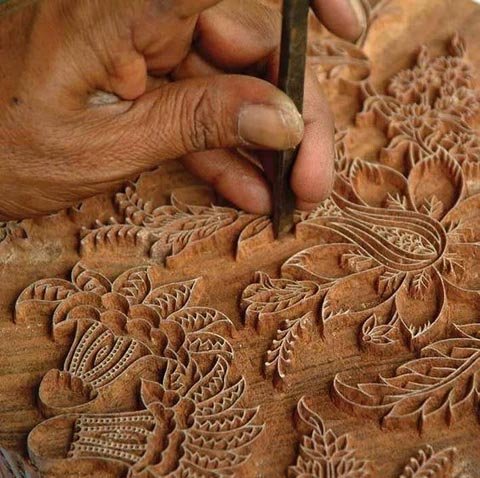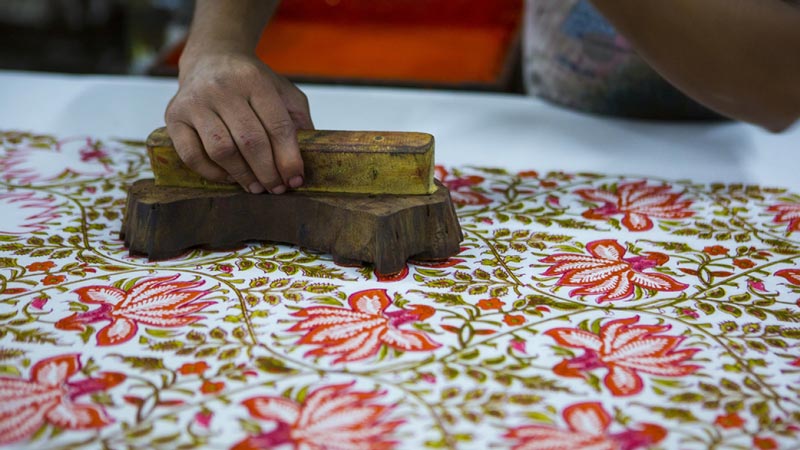Block printing is an ancient technique for creating intricate designs on fabric using wooden blocks. This traditional method of printing has been used for centuries in various parts of the world, and it is still a popular art form today. Let’s take a look at the history of block printing, how it is done, and its significance in modern times.
The History of Block Printing
The history of block printing dates back to ancient China, where it was used for printing on textiles and paper. From China, the technique spread to other parts of Asia, including India, Japan, and Indonesia. In India, block printing has been used for centuries to create beautiful textiles that are admired around the world.
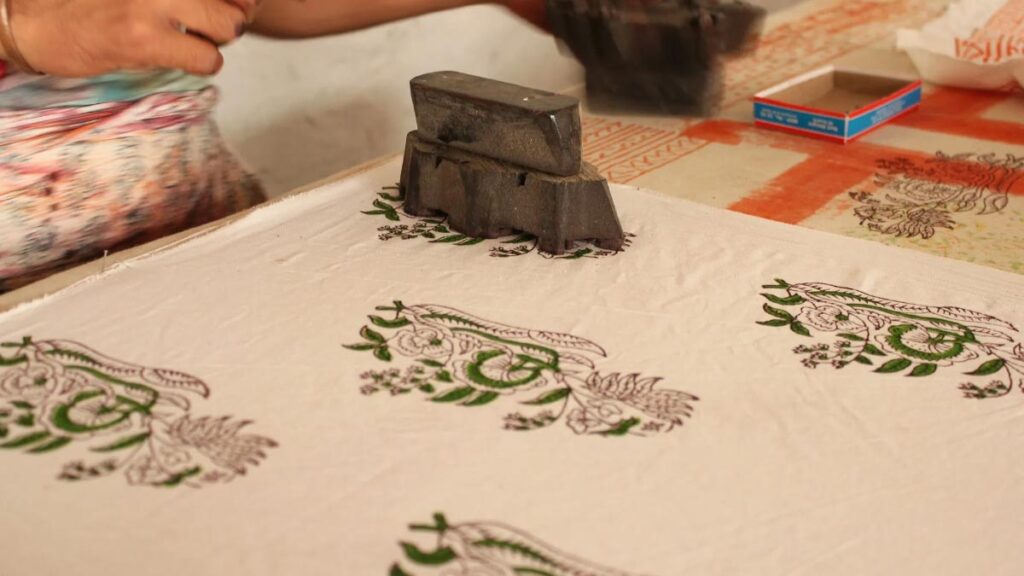
Block printing reached Europe in the 12th century and was used for printing on paper. The technique was used to print religious texts, books, and playing cards. It was during the Renaissance that blocks printing became a popular method for printing patterns and designs on fabrics. In the 17th and 18th centuries, block printing was used extensively in Europe for printing on cotton and silk fabrics.
Today, block printing continues to be a popular art form in many parts of the world. It is especially popular in India, where artisans create intricate designs on fabrics such as sarees, bed sheets, and tablecloths.
How Block Printing is Done?
Block printing involves using wooden blocks to print designs on fabric. The wooden block is first carved with the desired design, and then ink is applied to the block. The block is then pressed onto the fabric to transfer the design.
Carving the Block
The first step in block printing is carving the wooden block. The artisan uses a chisel and hammer to carve the design onto the block. The design can be a simple geometric pattern or a complex floral design. The block is usually made of teak wood or rosewood, which are hard and durable woods that can withstand the pressure of printing.
Preparing the Fabric
Before printing, the fabric is washed to remove any dirt or impurities. It is then stretched on a printing table, which is a flat surface that is covered with a layer of padding. The padding helps to absorb any excess ink and prevents the fabric from moving during printing.
Applying Ink to the Block
Ink is applied to the carved block using a brayer, which is a roller with a rubber surface. The ink is evenly spread over the surface of the block, ensuring that the entire design is covered. The brayer is then cleaned and the block is ready for printing.
Printing on the Fabric
To print on the fabric, the artisan places the inked block onto the fabric and applies pressure to it using a squeegee or baren. The block is lifted off the fabric, revealing the printed design. The artisan repeats this process, printing the design multiple times to create a pattern.
Drying and Finishing
After printing, the fabric is left to dry for several hours. Once the ink has dried, the fabric is washed to remove any excess ink or paste. It is then ironed to set the ink and make the fabric ready for use.
Components of Block Printing
- Wooden Block: carved with intricate designs, made of teak or rosewood
- Ink: water-based, should have the right consistency, come in vibrant colors
- Fabric: cotton is the most commonly used, should be pre-washed and dried
- Printing Table: a flat surface, usually made of wood, covered with wet sand
- Printing Paste: applied to the fabric to make it more receptive to ink and prevent bleeding
- Squeegee or Baren: used to press the block onto the fabric
- Dye Fixative: applied after printing to set the ink and prevent bleeding or fading.
Block Printing on Fabrics
Block printing on fabrics involves the use of a wooden block and ink. Here’s what you need to know about these tools:
Wooden Block
- Typically made of teak or rosewood, chosen for their density and durability
- Wood must be seasoned to avoid warping or cracking
- Design is drawn and carved by hand using chisels and gouges
- Each block is unique and can take days or weeks to complete
Ink
- Block printing ink is typically water-based
- Consistency of ink must be appropriate for the fabric being printed
- Natural and synthetic dyes are used to create colors
- Each color is applied separately
- Ink is applied to the block with a brush or roller and then pressed onto the fabric to transfer the design
Block Printing Techniques
Block printing involves several different techniques that can be used to create a variety of designs. Here are a few examples:
- Repeat Patterns: One of the most common block printing techniques is creating repeat patterns. This involves carving a block with a simple design and then using it to print the same design multiple times in a row to create a repeating pattern.
- Layering: Layering is another popular block printing technique that involves using multiple blocks to create a more complex design. Each block is carved with a different part of the design, and then the ink is applied and printed in layers to create the final image.
- Gradient Printing: Gradient printing involves using different shades of ink to create a gradient effect. This can be achieved by using a single block and varying the amount of ink applied, or by using multiple blocks with different levels of detail and ink saturation.
- Embossed Printing: Embossed printing is a technique that creates a raised or textured effect on the fabric or paper. This is achieved by carving the block in a way that creates a raised surface, which is then printed onto the fabric or paper.
The Advantages and Disadvantages of Block Printing
Block printing has both advantages and disadvantages, which are worth mentioning in the article:
| Advantages of Block Printing | Disadvantages of Block Printing |
|---|---|
| Unique Designs: Block printing allows for the creation of unique designs that cannot be replicated with other printing methods. Each print is handmade, giving it a personal touch and a one-of-a-kind feel. | Time-Consuming: Block printing is a time-consuming process that requires a lot of manual labor. Each print must be done by hand, making it difficult to mass-produce products in large quantities. |
| Sustainability: Block printing is a sustainable and eco-friendly alternative to modern printing methods that often use synthetic dyes and chemicals. Many block printers use natural dyes and organic fabrics, reducing the environmental impact of the printing process. | Cost: The handmade nature of block printing can make it a more expensive option compared to other printing methods. The cost of materials and labor can add up, making it difficult for small businesses or artisans to compete with larger manufacturers. |
| Cultural Heritage: Block printing is often associated with specific regions or cultures, such as Indian block printing or Japanese woodblock printing. This makes it a valuable part of cultural heritage, preserving traditional techniques and styles. | Imperfections: Block printing is a handmade process, which means that there may be imperfections or inconsistencies in the final product. This can add to the charm and uniqueness of the product, but it may not be suitable for some customers who prefer a more uniform look. |
Block Printing in India
Block printing has a rich history in India and is an integral part of the country’s textile industry. The art of block printing in India dates back to the 12th century, with evidence of printed textiles found in the excavations at Mohenjodaro and Harappa.
Block printing in India is known for its intricate designs and patterns, often inspired by nature, mythology, and everyday life. The designs are typically carved onto wooden blocks, which are then used to print on fabrics such as cotton, silk, and linen.
The block printing process in India is often done by hand, with artisans using natural dyes and traditional techniques to create unique and vibrant prints. Each region of India has its own style of block printing, with some of the most well-known styles including Bagru, Ajrakh, and Kalamkari.
Block printing in Jaipur, India, is not just a printing technique but a significant cultural heritage. It has been passed down for centuries, becoming an integral part of the city’s art and craft tradition. The unique style of block printing from small towns and villages like Bagru, Sanganer, and Akola has become synonymous with Jaipur. It is not just a means of livelihood for artisans but also a way of preserving their cultural heritage. The government has recognized its importance and taken initiatives to promote and preserve the art. Block printing in Jaipur is something that should be appreciated and celebrated by all.
Shop for Block Print Bedsheets online in India
-
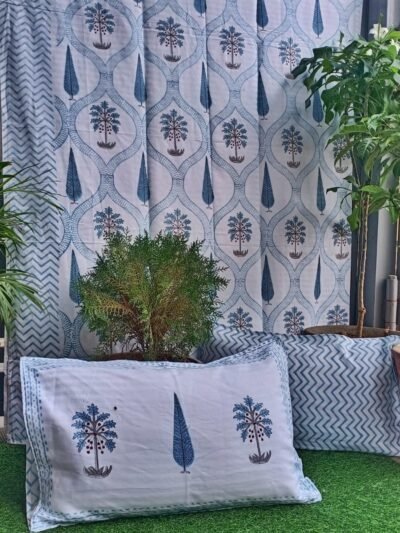 Jaal Floral Print – King Size Bed Sheet, Percale Cotton, White, Teal (108*108)₹2,199.00
Jaal Floral Print – King Size Bed Sheet, Percale Cotton, White, Teal (108*108)₹2,199.00 -
 Lilly Print King Size Bed Sheet – Percale Cotton, White (108*108)₹2,199.00
Lilly Print King Size Bed Sheet – Percale Cotton, White (108*108)₹2,199.00 -
 Hand Block Floral Print King Size Bed Sheet – Percale Cotton – Green, White (108*108)₹2,199.00
Hand Block Floral Print King Size Bed Sheet – Percale Cotton – Green, White (108*108)₹2,199.00 -
 Hand Block Floral Print King Size Bed Sheet – Percale Cotton – Sky Blue, White (108*108)₹2,199.00
Hand Block Floral Print King Size Bed Sheet – Percale Cotton – Sky Blue, White (108*108)₹2,199.00 -
 Mughal Print Handblock Pure Cotton King Size Bedsheet, White, Green (108*108)₹2,199.00
Mughal Print Handblock Pure Cotton King Size Bedsheet, White, Green (108*108)₹2,199.00 -
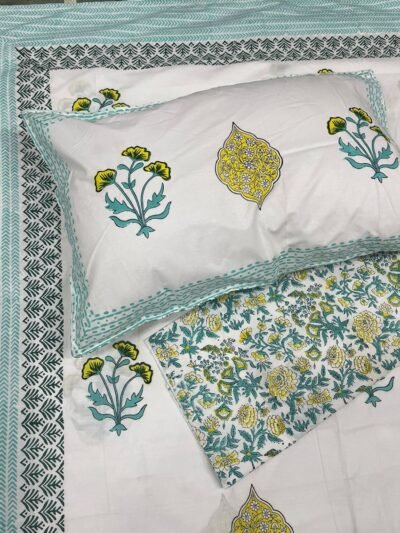 Hand Block Iris Flower Print King Size Bed Sheet – 100% Percale Cotton, (Sea Blue | 100 x 108 inches)₹2,199.00
Hand Block Iris Flower Print King Size Bed Sheet – 100% Percale Cotton, (Sea Blue | 100 x 108 inches)₹2,199.00 -
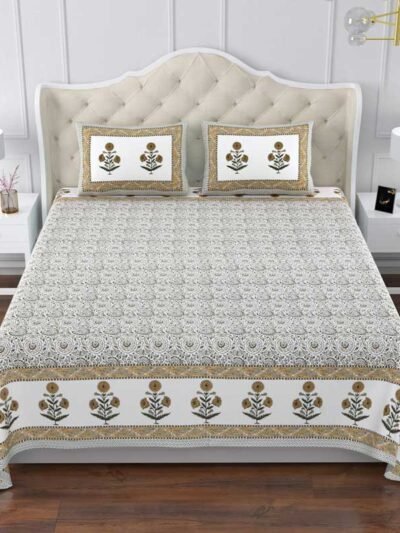 Elite – Cotton King Size Bedsheet – Floral Pattern, (Mustard & Gray | 100 x 108 inches)₹1,499.00
Elite – Cotton King Size Bedsheet – Floral Pattern, (Mustard & Gray | 100 x 108 inches)₹1,499.00 -
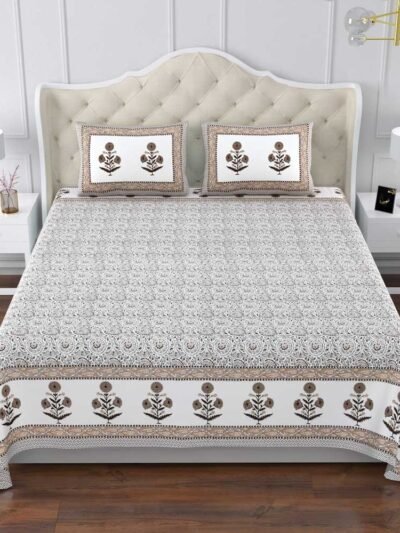 Elite Block Print Cotton King Size Bedsheet – Floral, Gray & Brown₹1,499.00
Elite Block Print Cotton King Size Bedsheet – Floral, Gray & Brown₹1,499.00 -
 Elite Block Print Cotton King Size Bedsheet – Floral Pattern, Blue & Gray₹1,499.00
Elite Block Print Cotton King Size Bedsheet – Floral Pattern, Blue & Gray₹1,499.00

